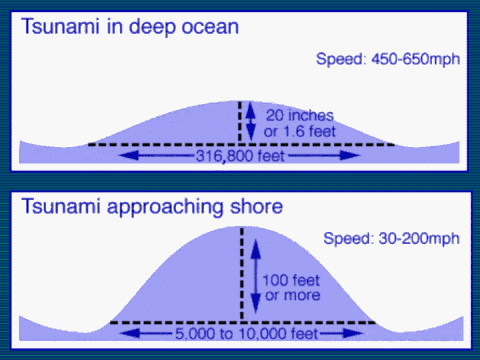| front |1 |2 |3 |4 |5 |6 |7 |8 |9 |10 |11 |12 |13 |14 |15 |16 |17 |18 |19 |20 |21 |22 |23 |24 |25 |26 |27 |28 |29 |30 |31 |32 |33 |34 |35 |36 |37 |38 |39 |40 |41 |42 |43 |44 |45 |46 |47 |48 |review |
 |
Tsunami speed
& ocean depth: "The speed at which tsunamis travel depends on the ocean depth. Tsunamis are shallow-water waves, which means that the ratio between water depth and wavelength is very small. These shallow-water waves move at a speed equal to the square root of the product of the acceleration of gravity (9.8m/s/s) and the water depth. Notice how the waves become larger as they reach shore, where the water is shallower. When the tsunami enters the shoaling water of coastlines in its path, the velocity of its waves diminishes and the wave height increases (shoaling effect). It is in these shallow waters that a large tsunami can crest to heights exceeding 100 feet (30 m) and strike with devastating force. A tsunami can exceed 500 mph (and a period of about one hour) in the deep ocean but slows to 20 or 30 mph in the shallow water near land. In less than 24 hours, a tsunami can cross the entire Pacific Ocean. In summary, The deeper the water, the faster the wave is, vise versa. Shoaling effect results in a tsunami that was imperceptible in deep water may grow to be several feet or more in height in the coastlines." Citation source: http://www.owlnet.rice.edu/~esci108/108_EQ_Lec_4.ppt |